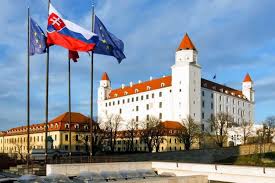April 2019 Humphrey Secretariat Post – Slovakia
 Greetings! My name is Julius and I am representing Slovakia in the 2019 cohort of Hubert H. Humphrey Fellows at the Vanderbilt University. I come from a young country with a long history, which is called by Pat Uskert – a History Channel documentarist – treasure in the heart of Europe.
Greetings! My name is Julius and I am representing Slovakia in the 2019 cohort of Hubert H. Humphrey Fellows at the Vanderbilt University. I come from a young country with a long history, which is called by Pat Uskert – a History Channel documentarist – treasure in the heart of Europe.
Indeed, this small country, is like a jewel box in the middle of Central Europe, south of Poland, full of natural beauty, charming historic cities, kindhearted people, and good food.
 Though its territory is just a little bigger than 49,000 km2 (approximately half times the size of Maryland) the geography of the country is varied and offers a lot for those who like hiking or skiing, enjoy tours in natural parks, would like to try rafting or canoeing in wild rivers in the rugged mountains of the north, or prefer biking from one historic place to another in the southern lowlands of the country. Our biggest river, the Danube is the natural border with Hungary, which is south of Slovakia, and with whom we share our longest border (627km). The country is also famous for its crystal-clear mineral waters and natural thermal springs. Wellness and spa culture are at a very high level there.
Though its territory is just a little bigger than 49,000 km2 (approximately half times the size of Maryland) the geography of the country is varied and offers a lot for those who like hiking or skiing, enjoy tours in natural parks, would like to try rafting or canoeing in wild rivers in the rugged mountains of the north, or prefer biking from one historic place to another in the southern lowlands of the country. Our biggest river, the Danube is the natural border with Hungary, which is south of Slovakia, and with whom we share our longest border (627km). The country is also famous for its crystal-clear mineral waters and natural thermal springs. Wellness and spa culture are at a very high level there.
The country’s total population is about 5,5 million and is evenly distributed, with a slightly bigger concentration in the west, near the capital city – Bratislava. Many tourists arrive in our biggest city from Vienna (Austria’s capital city), which is just 65km away from Bratislava.
Slovakia is a wonderful place to live for its rich cultural heritage and hospitality of its inhabitants. If you love good food you will surely find what you search for let it be fresh fruits of vegetables, wonderful meats or traditional pasta.  You should surely try the traditional cabbage soup, which is my favorite. This country also offers a variety of quality wines and beers and you can also try some of the famous fruit brandies. Centuries long folk traditions are still preserved, and people can visit an endless number of festivals almost throughout the whole year where they can enjoy the spectacular shows of folk dancing groups.
You should surely try the traditional cabbage soup, which is my favorite. This country also offers a variety of quality wines and beers and you can also try some of the famous fruit brandies. Centuries long folk traditions are still preserved, and people can visit an endless number of festivals almost throughout the whole year where they can enjoy the spectacular shows of folk dancing groups.
 Slovakia is a developed country – the hub of car manufacturing industry in Central Europe – with parliamentary democracy, full membership in the European Union and the NATO and with representation in all internationally significant organizations. We have been using Euro as our currency since 2009. The Slovak GDP growth was 3.4% in 2017 with 6.2% unemployment rate in January 2019.
Slovakia is a developed country – the hub of car manufacturing industry in Central Europe – with parliamentary democracy, full membership in the European Union and the NATO and with representation in all internationally significant organizations. We have been using Euro as our currency since 2009. The Slovak GDP growth was 3.4% in 2017 with 6.2% unemployment rate in January 2019.
The education system in Slovakia has undergone numerous waves of reforms since 1993. Education is free in Slovakia from kindergarten until the university graduation. The adult literacy rate has long decades been above 99% and approximately 12% of the total population has earned a postsecondary degree. By the political transformation from a post-communist country to a liberal democracy based on open market and efficient production and investment models, the role of education has also changed. There is more need now than ever before, to adjust educational and research outcomes to the needs of the markets and produce high quality research that support decision making and business. My goal, during my stay in the USA, is to learn as much as possible about policy analysis and educational management and understand the dynamics of education-market interactions to better foster the development of my country and help adjust the educational procedures to enable our graduate students to build successful careers at home.

This is the biggest challenge in Central Europe as many highly-trained professionals have left Slovakia for economic benefits. Brain drain is a considerable obstacle in further development of this beautiful country. As an assistant professor at the Department of British and American Studies of the Pavol Jozef Safarik University in Kosice, I am convinced that our society will be able to give adequate answer to this challenge and the Slovak education system will maintain its good traditions and prepare the next generations for the competition that characterizes our globalized world.